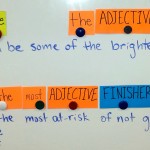Are we in a post-truth society? Are we hopelessly floating in our bubbles of alternative facts and biased narratives? Or can reasoning and evidence prevail? The truth is that sometimes, one doesn’t even need the facts to be “alternative” to come up with the wrong story to explain them. I believe that perhaps the most warped lens through which to view reality is the lens of fear.
In December, I blogged about my anxiety in discussing the current English Language Learner graduation rates in Arizona with my junior high students. They have so much to learn, and so quickly, that it is easy to worry when they waste time or go off-task. The reality of the 18% ELL graduation rate in Arizona seemed to be one way to get my students thinking about how they are using their time.
If you read the comments section after the post, you can see that my colleague Angelia Ebner raised interesting questions about this graduation rate, and whether the low numbers had become a false narrative about English Language Learners in Arizona. When I looked into it, I decided that yes, one couldn’t take the number at face value. This is because the sad, sad graduation rate for ELL’s does not include students who test proficient in English before graduation. The 18% graduation rate for ELL’s is calculated based on the students that are currently English Language Learners at the time of graduation. And actually, as of 2015 the rate was 25%.
In fact, I also learned that the younger students are when they pass AZELLA, the more likely they are to graduate on time. Which means that although my students are still behind the eight-ball, they do have time. If they work hard now, they can be successful and graduate on time. In fact, I would argue that most of them will be absolutely fine.
Fine. I feel better. We still can’t be flipping water bottles and discussing YouTube all period, but (mostly) it is all going to be okay.
The tougher lesson for me, however, is that, as I should know by now, it is best not to act from a place of fear. Even though I daily remind my students that they are highly capable, and try to give them the tools to move forward, and hold them to high standards that will challenge them, and even though I don’t “teach to the test” so much as I work toward authentic learning experiences, I myself still metaphorically bite my nails over the AZELLA test. And I need to stop. It is not good for me, or my students.
Worse, my anxiety is based on a misinterpretation of a number that was pulled out of context. The thing is, that number had been used out of context in multiple newspaper stories and blog posts, which is why I was able to find it quickly in the middle of class and latch onto it. Teachers and journalists love to fight for the underdog, and so it makes sense that we are willing to grab onto a number that shows we need more support for ELL’s and use it for our purposes. It is still a concerning number, but it doesn’t mean what I originally assumed that it did.
We need to do better for our students. When I say “we,” I mean “I.” Question every statistic, especially when it is used to send a message about student achievement, or to promote a specific political agenda. Question the numbers, even when they appear to support your message. While in some circles, alternative facts may be used to justify policy, we are educators. What is the point of our profession if we, too, are willing to accept the stories told by the numbers without question?











Comments 2
I love to read your transparency as an ELL teacher. Thank you for your dedication and commitment to these kiddos!! I was an Language Acquisition Mentor at our school- managing all the ILLPs for the ELL students. I will say- at least in our school- about 80% of our ELL students are also ESS! We only had 2 out of 20 students pass the AZELLA, which I was given a rather stern “tsk tsk” over this lack of achievement. I was aghast at that reaction– they can’t read because they also have learning disabilities!!! But also, our district seems to think that creating an ILLP for an ELL Student will magically provide better education for them. Yet I see a resistance and attitude from ELL teachers who hate the extra paperwork and don’t seem to be very committed to passing the AZELLA. Such a sad cycle. And the kids are the victims of it all.